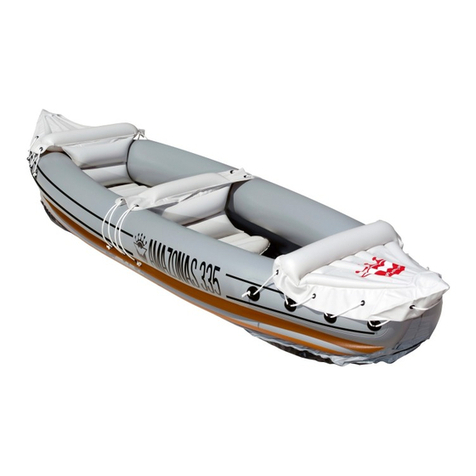
7
Vorbereitung zum Aufblasen des Bootes
• Den Untergrund von allen spitzen oder scharfkantigen Gegen ständen säubern.
• Das Boot in voller Länge und Breite auf dem vorher gesäuberten Untergrund ausbreiten.
Dabei Temperaturen unter 15 ºC vermeiden.
• Bei erstmaliger Verwendung die Schraubventile mit Gefühl fest in die dafür vorgesehenen
Sockel der nummerierten Luftkammern einschrauben.
• Das noch nicht aufgeblasene Boot nicht betreten, um die Folie nicht zu beschädigen.
Aufblasen des Bootes
Zum Aufblasen am besten eine Luftpumpe aus dem WEHNCKE-Aufblaspumpenprogramm
verwenden. Verwenden Sie niemals einen Kompressor oder Pressluft!
Zum Aufblasen wie folgt vorzugehen:
Verschluss des Schraubventils der Kammer 1 aufschrauben und die Pumpe anschließen. Bei
Verwendung einer Doppelhubpumpe den Verbindungssschlauch an den mit der Aufschrift
‚Inate’ versehenen Pumpenstutzen anschließen und den Adapter in das geöffnete Ventil
fest einstecken. Nach dem Befüllen den Adapter herausziehen und den Schraubverschluss
wieder auf das Ventil aufschrauben.
Zum Aufblasen der Kammer 2 ist nach der gleichen Methode vorzugehen. Das Aufblasen
ist solange auszuführen, bis der vorgegebene Betriebsdruck der jeweiligen Luftkammer er-
reicht ist. Die Betriebsdrücke der einzelnen Luftkammern sind der unten stehenden Tabelle zu
entnehmen. Zur Kontrolle des vorgesehenen Luftdrucks sind auf den beiden Hauptkammern
Kontrollanzeigen angebracht. Der Betriebsdruck ist erreicht, wenn die Spitze des Anzeige-
bandes auf den der Umgebungstemperatur entsprechenden Markierungsstrich zeigt (siehe
Abbildung 1).
Weitere Luftkammern mit Schraubventilen, soweit vorhanden, sind ebenfalls in der vorste-
hend beschriebenen Weise aufzublasen. Das Erreichen des erforderlichen Betriebsdruckes
ist durch Eindrücken mit dem Daumen im Vergleich mit den Hauptkammern zu überprüfen.
Die Folie muss sich dann bei mäßiger Kraft noch ca. 1 cm tief eindrücken lassen. Die Boden-
kammern sind unter Verwendung eines mit der Pumpe mitgelieferten geeigneten Adapters
über das Stöpselventil aufzublasen. Dazu muss das Ventil vollständig herausgezogen und der
Stöpsel abgenommen werden. Bei Verwendung einer Doppelhubpumpe ist wie oben be-
schrieben zu verfahren und nach dem Aufblasen und Abziehen des Adapters das Ventil mit
dem Stöpsel wieder zu verschließen. Anschließend ist das Ventil soweit wie möglich in die
Luftkammer einzudrücken. Bitte beachten Sie, dass das Boot Typ „Olympic 190“ nur mit Stöp-
selventilen (keine Schraubventile) ausgestattet ist.
Entleeren der Luftkammern
Zum Entleeren der Luftkammern muss das gesamte Schraubventil herausgeschraubt werden.
Zur Unterstützung des Entleerens benutzen Sie die beiliegenden Röhrchen, die dazu in den
Ventilsockel eingesteckt werden.
Zur kontrollierten Verringerung des Luftdrucks der Auftriebskammern den Verschluss des
Schraubventils öffnen, kurzzeitig den dann sichtbar werdenden Stift zum Öffnen des Rück-
schlagventils eindrücken bis der gewünschte verringerte Luftdruck erreicht ist. Zum Entleeren





























